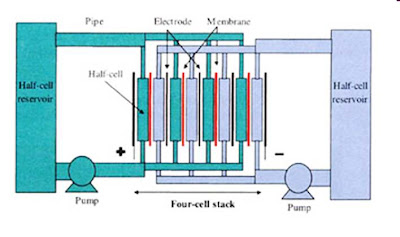One of World's Largest
Flow Battery Systems
for
Irish Wind Farm
Flow Battery Systems
for
Irish Wind Farm
Kevin Cullen, who has contributed to this blog on a number of occasions, has been in touch to point out a Press Release from VRB Power Canada about an important wind farm deal in Ireland. Thanks Kevin!!
VRB Power Canada has recently announced the sale of a large scale Redox type flow battery system for the Sorne Hill Wind farm, located in Buncrana, Ireland. AFAIK the sale is pending and not as yet complete, but this may have been accomplished since my last information.

The battery capacity will provide 12 MegaWatt hours of power when fully charged. That’s like the power of 12 fair sized turbines whirring flat out for an hour, or three whirring for 4 hours. It also means that the battery can supply 2 mega watts for 6 hours – 2,000 one bar electric fires worth of power.

This mega-sized battery’s power will essentially fill in the power gaps left when the wind dies down. It won’t be a lot of good though if there is no wind for several days. One of these huge batteries is capable of storing enough power to keep a small town going.
VBR have also announced that they hired ex ESB MD Kieran O’Brien to “assist in developing Energy Storage Adoption in Irish market”, whatever that actually means – advisor, spokesman, salesman??.
The company has developed an actual working Redox type pumped electrolyte battery, something like what Plurion are trying to achieve but AFAIK have not yet perfected.
Construction of the 6MW, smallish, wind farm is to foundation stage. Turbine delivery is expected in just weeks. SEI are involved in completing the deal – but that does not give me any reason for confidence in the project.
Even though the wind farm is a relatively small one, the fact that it will have battery back up is fairly unique in Ireland. That there will be such a large battery system puts it in line for the Guinness Book of Records as a world first.
I am all in favour of this type of storage system – it will make wind power a truly viable alternative for Ireland. Wind power has the problem of being variable and there is a defined need to have some way of filling in the low wind gaps in power generation. The Flow-Battery is one such system.
Good Luck to Sorne Hill Farm, VBR Power and Kieran O’Brien.
.


1 comment:
Tony,
Good post. I did want to point out one key point regarding VRB's Energy Storage System (ESS): it's now well beyond the prototype stage.
Utilities are notoriously conservative buyers and typically require a lot of field tests -- and corresponding data -- before implementing new solutions in their grids.
Indeed, my take is that VRB Power is today at the cusp of mass commercialization.
As to some of the more salient earlier sales, in 2002, a 200kW x 4hr VRB-ESS was installed at King Island, Tasmania which has been used to balance wind and diesel generation on King Island and to reduce diesel usage and emissions.
In 2004, an installation for PacifiCorp in Castle Valley, Utah was the first large-scale commercial VRB-ESS in North America. It's now been operating continuously for over 4 years. The 350kVa X 8 hour (2 MWh) unit, which is connected to a 331km 25kV rural feeder, is being used as a load levelling (peak shaving) device to supply peak power capacity to a remote location in southeast Utah.
In 2006, Sumitomo installed a 4MW x 1.5hr VRB-ESS at the 32 MW Tomamae wind farm on Hokkaido in northern Japan to smooth output from the wind farm. Over the past three years, the system has cycled over 100,000 times and proves the viability of VRB's technology as the only large scale technology capable of rapid cycling and smoothing of the wind farm output.
VRB Power is also targeting the telcom market segment.
They recently sold a 20kw x 9hr VRB-ESS to a Sprint. The system provides the requisite 3 hours of backup US telcoms traditionally deploy. The additional 6hrs of storage capacity will provide the telcom operator the ability to arbitrage their purchase of electricity as they will charge the battery at night, when rates are lowest, to use the electricity during the high-rate day period.
Equally important are the very significant savings that have been made in the manufacturing area. An injection molded frame was developed which have yielded a 50% reduction in the overall cost of a 5kW cell stack. In so doing, they've eliminated all previous sub-assembly steps and enabled a final operational process that significantly reduces labor and floor space requirements.
I would invite anyone interested in any of this to read the company's 2007 Annual report available at www.vrbpower.com. Lot's of excellent detail -- before even getting to the numbers!
Best regards,
Kevin Cullen
Post a Comment